Development of Antibacterial Cotton Textiles by Deposition of Fe2O3 Nanoparticles Using Low-Temperature Plasma Sputtering
Abstract
:1. Introduction
2. Materials and Methods
2.1. Preparation of Samples
2.2. Characterization of Materials
2.3. Collection of Microbial Strains
2.4. Determination of Antibacterial Activity of Cotton Fabric Textile Coated with Fe2O3
2.5. Statistical Analysis
3. Results and Discussion
3.1. Deposition of Fe2O3 Nanoparticles on the Cotton Fabric
3.2. Deposition of Fe2O3 Nanoparticles on the Glass Slide
3.3. Antimicrobial Activity of Cotton Fabrics with Two Sides Coated with Fe2O3 NPs against 16 Microorganisms
4. Conclusions
Author Contributions
Funding
Data Availability Statement
Conflicts of Interest
References
- Rethinam, S.; Ramamoorthy, R.; Robert, B.; Nallathambi, G. Production of silica nanoparticles bound fabrics and evaluation of its antibacterial/ultraviolet protection properties. Micro Nano Lett. 2018, 13, 1404–1407. [Google Scholar] [CrossRef]
- Shah, M.A.; Pirzada, B.M.; Price, G.; Shibiru, A.L.; Qureshi, A. Applications of nanotechnology in smart textile industry: A critical review. J. Adv. Res. 2022, 22, 55–75. [Google Scholar] [CrossRef]
- Cotton: Industries: WWF. World Wildlife Fund. Available online: https://www.worldwildlife.org/industries/cotton (accessed on 1 August 2023).
- Granados, A.; Pleixats, R.; Vallribera, A. Recent Advances on Antimicrobial and Anti-Inflammatory Cotton Fabrics Containing Nanostructures. Molecules 2021, 26, 3008. [Google Scholar] [CrossRef] [PubMed]
- Qian, J.; Dong, Q.; Chun, K.; Zhu, D.; Zhang, X.; Mao, Y.; Culver, J.N.; Tai, S.; German, J.R.; Dean, D.P.; et al. Highly stable, antiviral, antibacterial cotton textiles via molecular engineering. Nat. Nanotechnol. 2023, 18, 168–176. [Google Scholar] [CrossRef] [PubMed]
- Abou Elmaaty, T.M.; Elsisi, H.; Elsayad, G.; Elhadad, H.; Plutino, M.R. Recent Advances in Functionalization of Cotton Fabrics with Nanotechnology. Polymers 2022, 14, 4273. [Google Scholar] [CrossRef]
- Giedraitienė, A.; Ruzauskas, M.; Šiugždinienė, R.; Tučkutė, S.; Milcius, D. Antimicrobial Properties of CuO Particles Deposited on a Medical Mask. Materials 2022, 15, 7896. [Google Scholar] [CrossRef] [PubMed]
- Brobbey, K.J.; Haapanen, J.; Tuominen, M.; Mäkelä, J.; Gunell, M.; Eerola, E.; Saarinen, J.J.; Toivakka, M. High-speed production of antibacterial fabrics using liquid flame spray. Text. Res. J. 2020, 90, 503–511. [Google Scholar] [CrossRef]
- Pourmadadi, M.; Rahmani, E.; Shamsabadipour, A.; Mahtabian, S.; Ahmadi, M.; Rahdar, A.; Díez-Pascual, A.M. Role of Iron Oxide (Fe2O3) Nanocomposites in Advanced Biomedical Applications: A State-of-the-Art Review. Nanomaterials 2022, 12, 3873. [Google Scholar] [CrossRef]
- Al-Zahrani, F.A.M.; Salem, S.S.; Al-Ghamdi, H.A.; Nhari, L.M.; Lin, L.; El-Shishtawy, R.M. Green Synthesis and Antibacterial Activity of Ag/Fe2O3 Nanocomposite Using Buddleja lindleyana Extract. Bioengineering 2022, 9, 452. [Google Scholar] [CrossRef]
- Halliah, G.P.; Alagappan, K.; Sairam, A.B. Synthesis, characterization of CH-α-Fe2O3 nanocomposite and coating on cotton, silk for antibacterial and UV spectral studies. J. Ind. Text. 2014, 44, 275–287. [Google Scholar] [CrossRef]
- Isik, Z.; Bouchareb, R.; Arslan, H.; Özdemir, S.; Gonca, S.; Dizge, N.; Balakrishnan, D.; Prasad, S.V.S. Green synthesis of iron oxide nanoparticles derived from water and methanol extract of Centaurea solstitialis leaves and tested for antimicrobial activity and dye decolorization capability. Environ. Res. 2023, 219, 115072. [Google Scholar] [CrossRef] [PubMed]
- Vihodceva, S.; Šutka, A.; Sihtmäe, M.; Rosenberg, M.; Otsus, M.; Kurvet, I.; Smits, K.; Bikse, L.; Kahru, A.; Kasemets, K. Antibacterial Activity of Positively and Negatively Charged Hematite (α-Fe2O3) Nanoparticles to Escherichia coli, Staphylococcus aureus and Vibrio fischeri. Nanomaterials 2021, 11, 652. [Google Scholar] [CrossRef] [PubMed]
- Alghamdi, H.M.; Abutalib, M.M.; Rajeh, A.; Mannaa, M.A.; Nur, O.; Abdelrazek, E.M. Effect of the Fe2O3/TiO2 Nanoparticles on the Structural, Mechanical, Electrical Properties and Antibacterial Activity of the Biodegradable Chitosan/Polyvinyl Alcohol Blend for Food Packaging. J. Polym. Environ. 2022, 30, 3865–3874. [Google Scholar] [CrossRef]
- Attia, N.F.; Abd El-Monaem, E.M.; El-Aqapa, H.G.; Elashery, S.E.A.; Eltaweil, A.S.; El, M.; Khalifa, S.A.M.; Hawash, H.B.; El-Seedi, H.R. Iron oxide nanoparticles and their pharmaceutical applications. Appl. Surf. Sci. Adv. 2022, 11, 100284. [Google Scholar] [CrossRef]
- Owonubi, S.J.; Malima, N.M.; Revaprasadu, N. Chapter 16—Metal Oxide–Based Nanocomposites as Antimicrobial and Biomedical Agents. In Antibiotic Materials in Healthcare; Kokkarachedu, V., Kanikireddy, V., Rotimi Sadiku, R., Eds.; Academic Press: Cambridge, MA, USA, 2020; pp. 287–323. [Google Scholar]
- Cai, Y.; Huang, F.; Wei, Q.; Wu, E.; Gao, W. Surface functionalization, morphology and thermal properties of polyamide6/O-MMT composite nanofibers by Fe2O3 sputter coating. Appl. Surf. Sci. 2008, 254, 5501–5505. [Google Scholar] [CrossRef]
- Chambers, S.A. Epitaxial growth and properties of thin film oxides. Surf. Sci. Rep. 2000, 39, 105–180. [Google Scholar] [CrossRef]
- Prucek, R.; Tuček, J.; Kilianová, M.; Panáček, A.; Kvítek, L.; Filip, J.; Kolář, M.; Tománková, K.; Zbořil, R. The targeted antibacterial and antifungal properties of magnetic nanocomposite of iron oxide and silver nanoparticles. Biomaterials 2011, 32, 4704–4713. [Google Scholar] [CrossRef]
- Karthik, C.; Rajalakshmi, S.; Thomas, S.; Thomas, V. Intelligent polymeric biomaterials surface driven by plasma processing. Curr. Opin. Biomed. Eng. 2023, 26, 100440. [Google Scholar] [CrossRef]
- The European Committee on Antimicrobial Susceptibility Testing. Breakpoint Tables for Interpretation of MICs and Zone Diameters, Version 13.1, Valid from 29 June 2023 (or Another Relevant Version and Year). Available online: http://www.eucast.org/clinical_breakpoints/ (accessed on 31 August 2023).
- The R Project for Statistical Computing. Available online: https://www.r-project.org/ (accessed on 31 August 2023).
- Nadi, A.; Sbai, S.J.; Bentiss, A.; Belaiche, M.; Briche, S.; Gmouh, S. Application of Fe3O4 nanoparticles on cotton fabrics by the Pad-Dry-Cure process for the elaboration of magnetic and conductive textiles. IOP Conf. Ser. Mater. Sci. Eng. 2020, 827, 012021. [Google Scholar] [CrossRef]
- Islam, S.; Callender, A.C.; Ho, Q.N.; Wakeman, C.A. Iron restriction induces the small-colony variant phenotype in Staphylococcus aureus. Front. Microbiol. 2022, 13, 978859. [Google Scholar] [CrossRef] [PubMed]
- Cheryl, B.J. The role of iron in the immune response to bacterial infection. Immunol. Res. 2011, 50, 1–9. [Google Scholar] [CrossRef] [PubMed]
- Slavin, Y.N.; Asnis, J.; Häfeli, U.O.; Bach, H. Metal nanoparticles: Understanding the mechanisms behind antibacterial activity. J. Nanobiotechnol. 2017, 15, 65. [Google Scholar] [CrossRef] [PubMed]
- Alangari, A.; Alqahtani, M.S.; Mateen, A.; Kalam, M.A.; Alshememry, A.; Ali, R.; Kazi, M.; AlGhamdi, K.M.; Syed, R. Iron Oxide Nanoparticles: Preparation, Characterization, and Assessment of Antimicrobial and Anticancer Activity. Adsorpt. Sci. Technol. 2022, 2022, 1562051. [Google Scholar] [CrossRef]
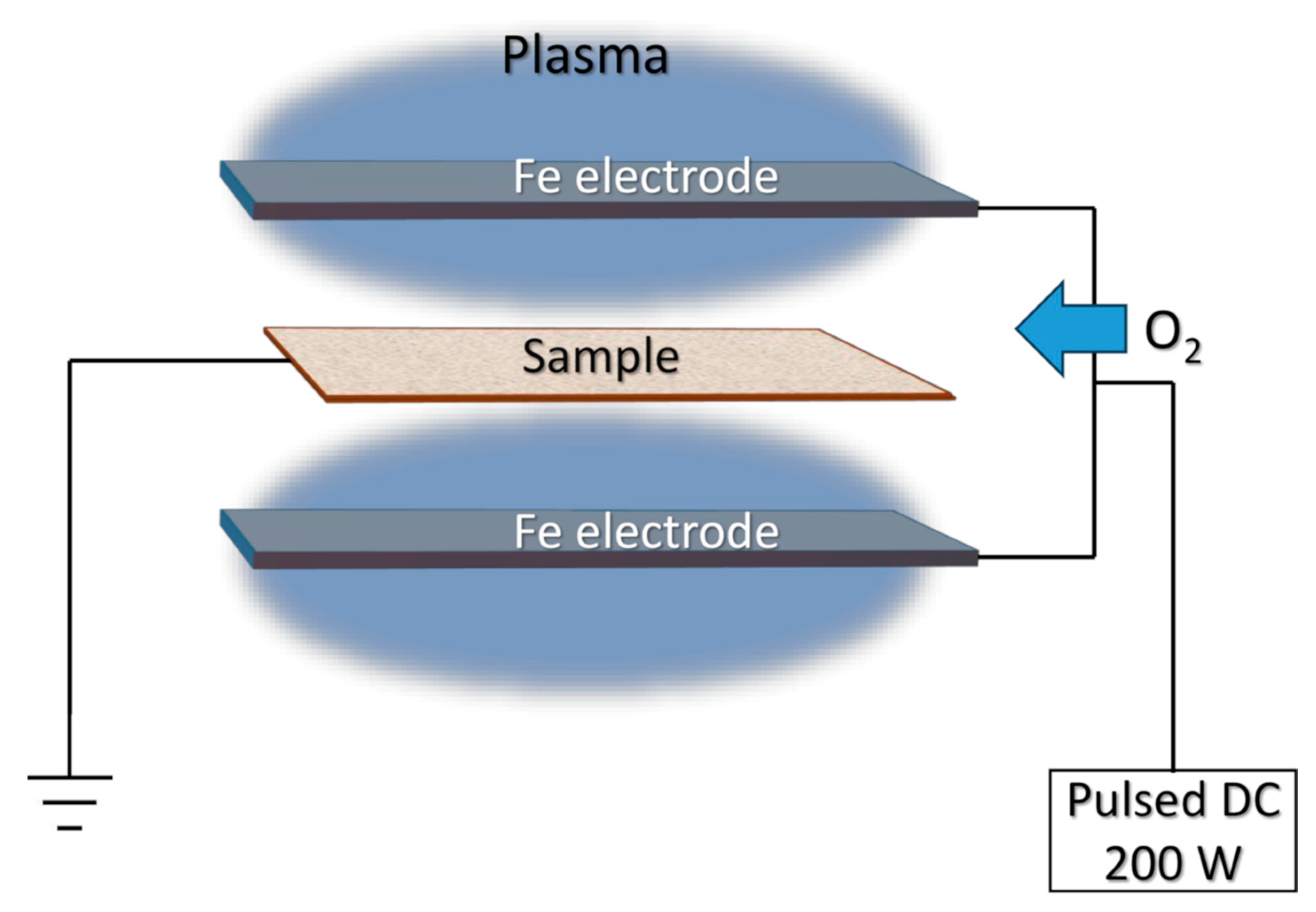
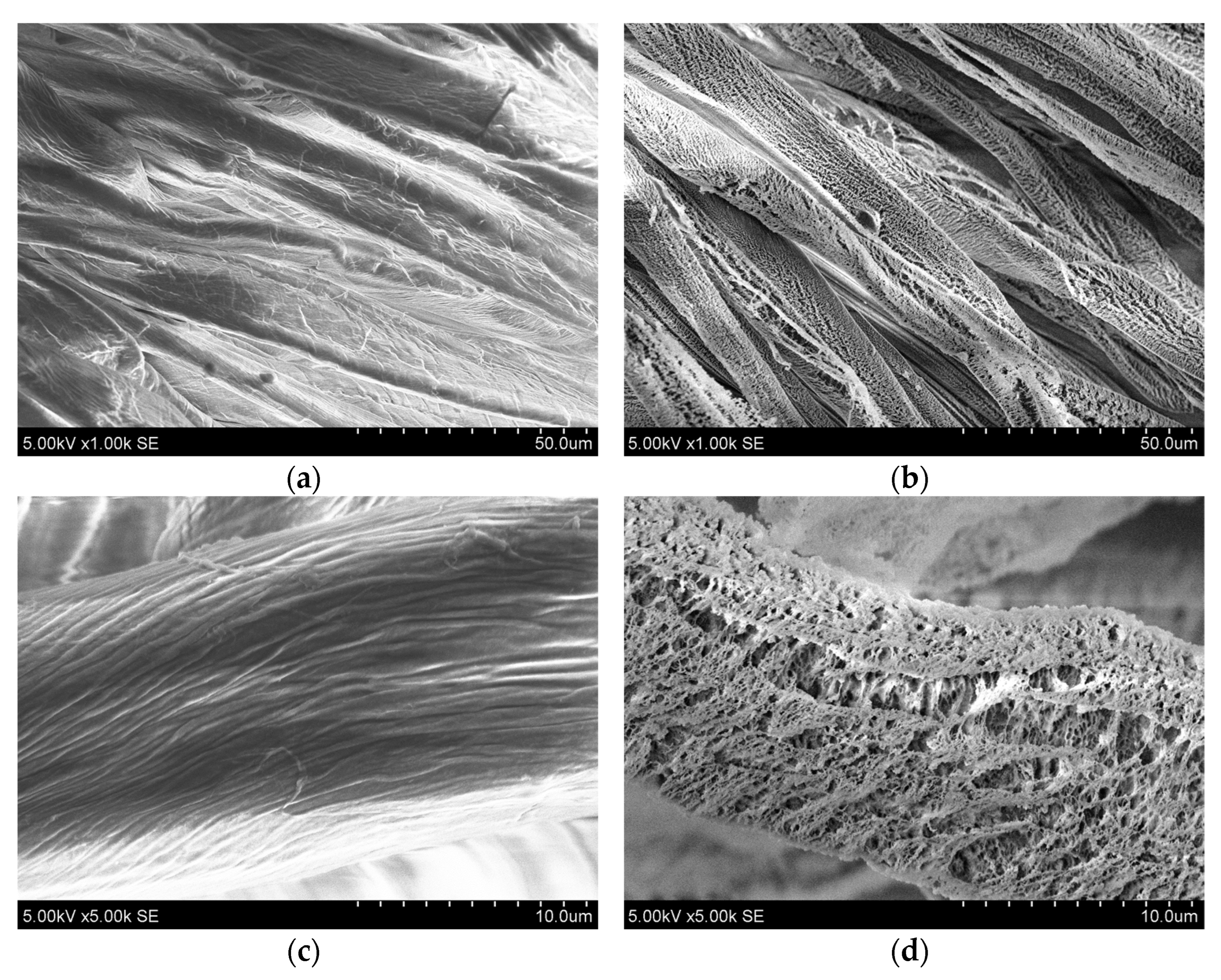
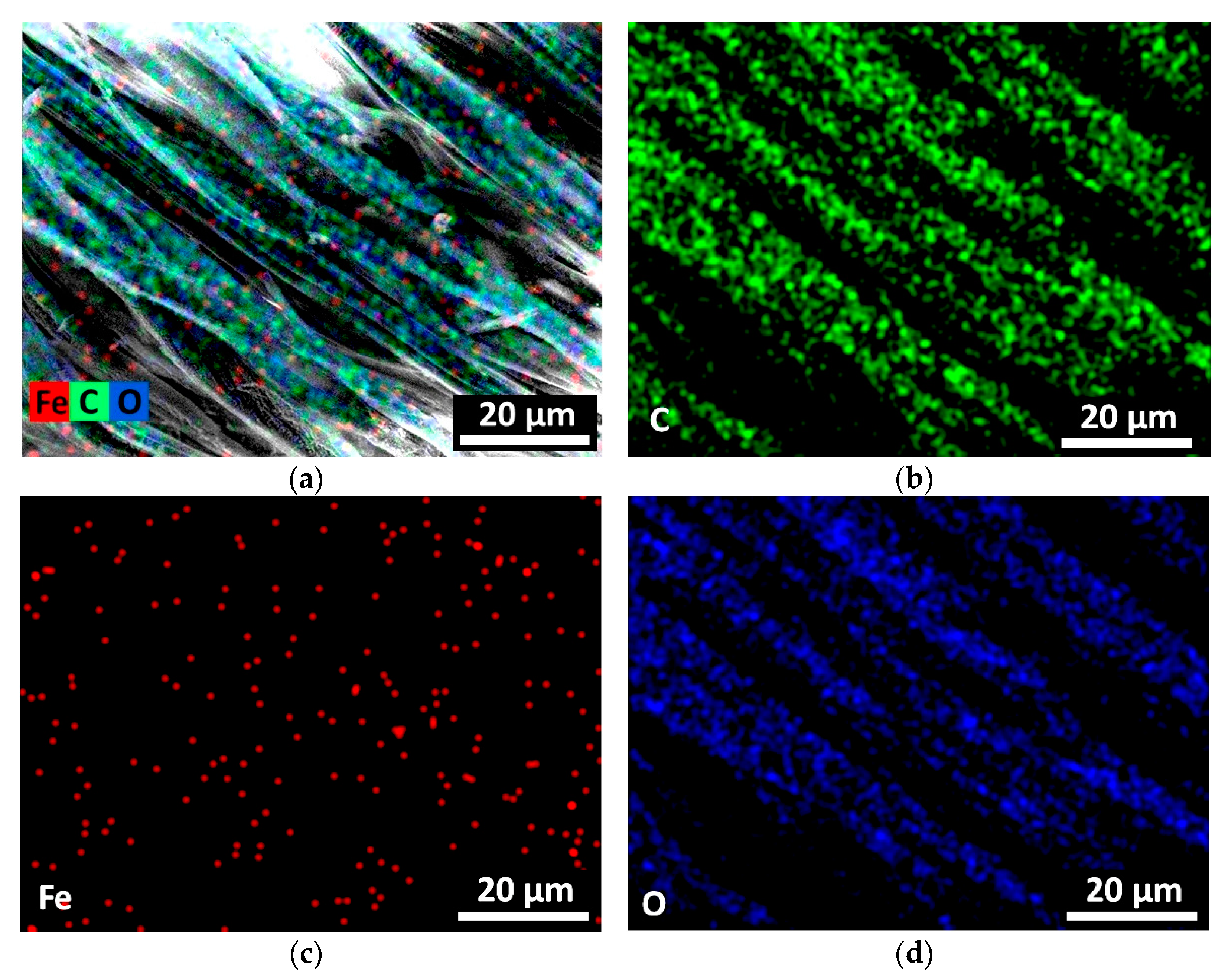

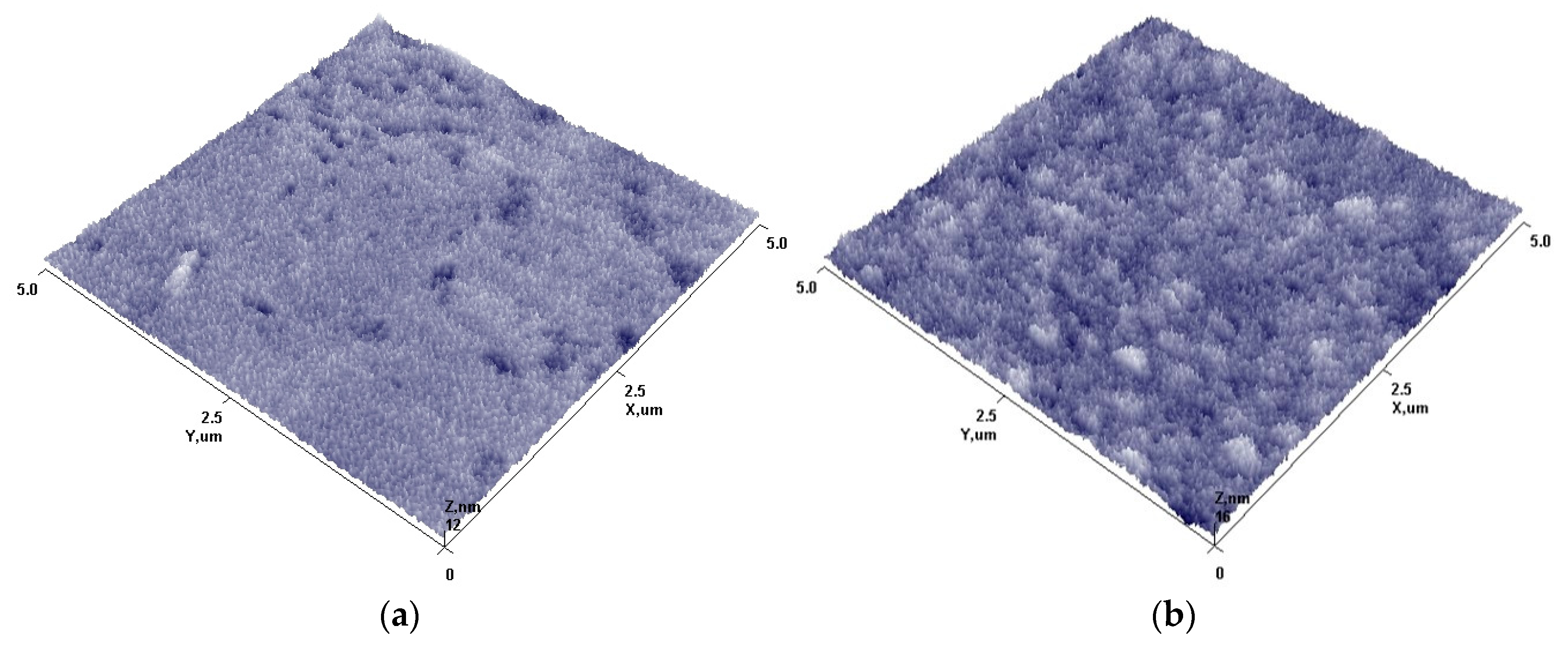

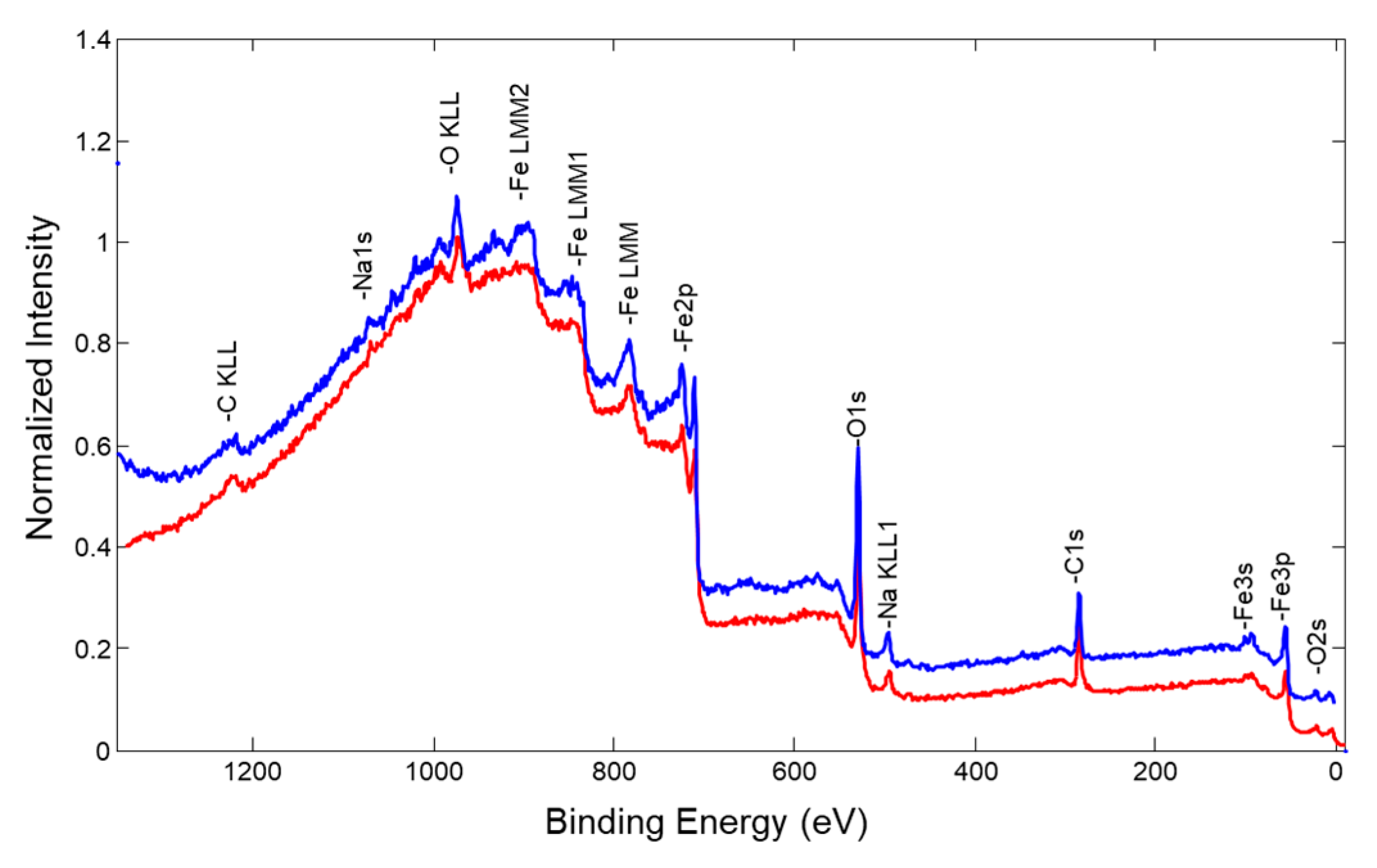
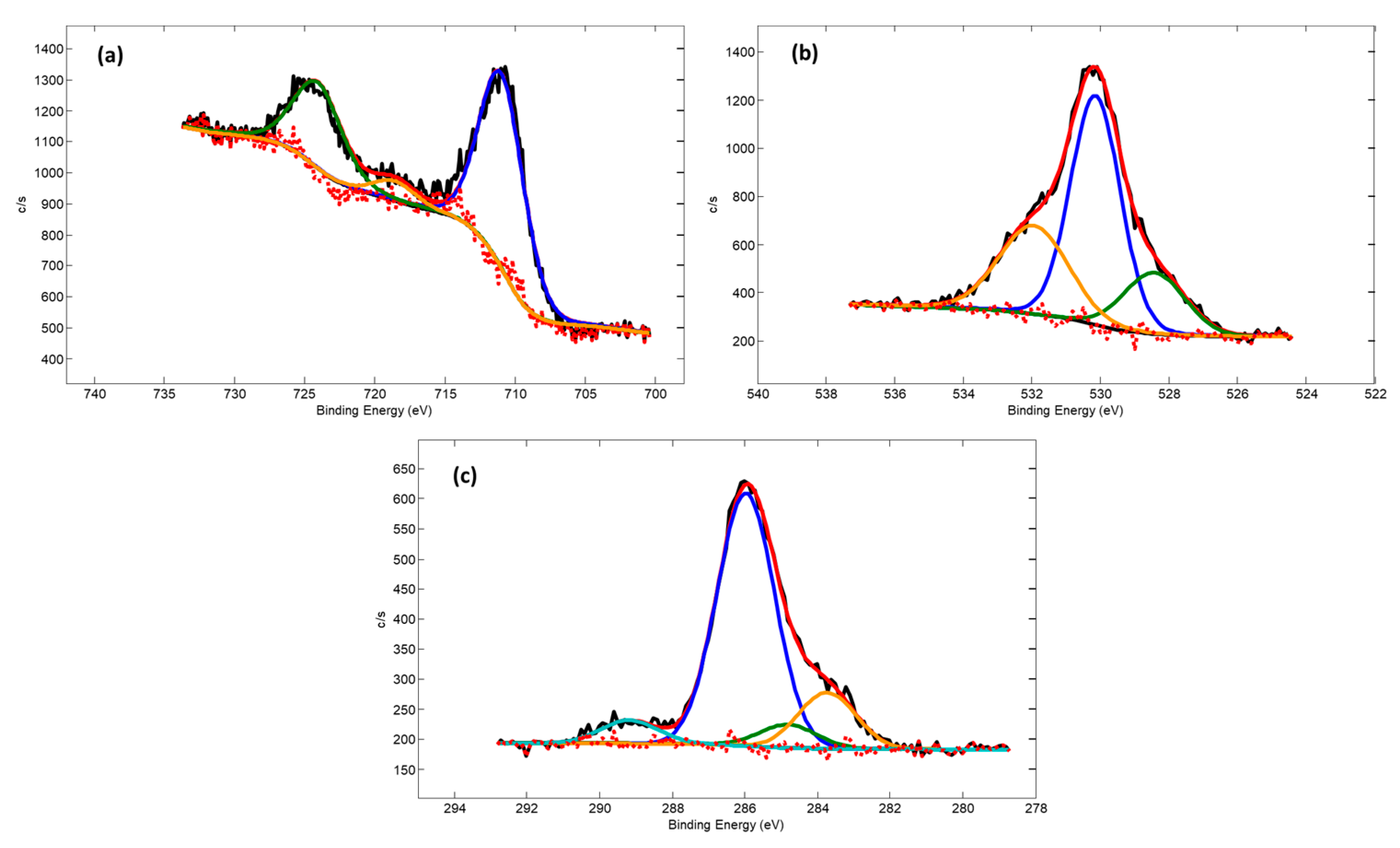

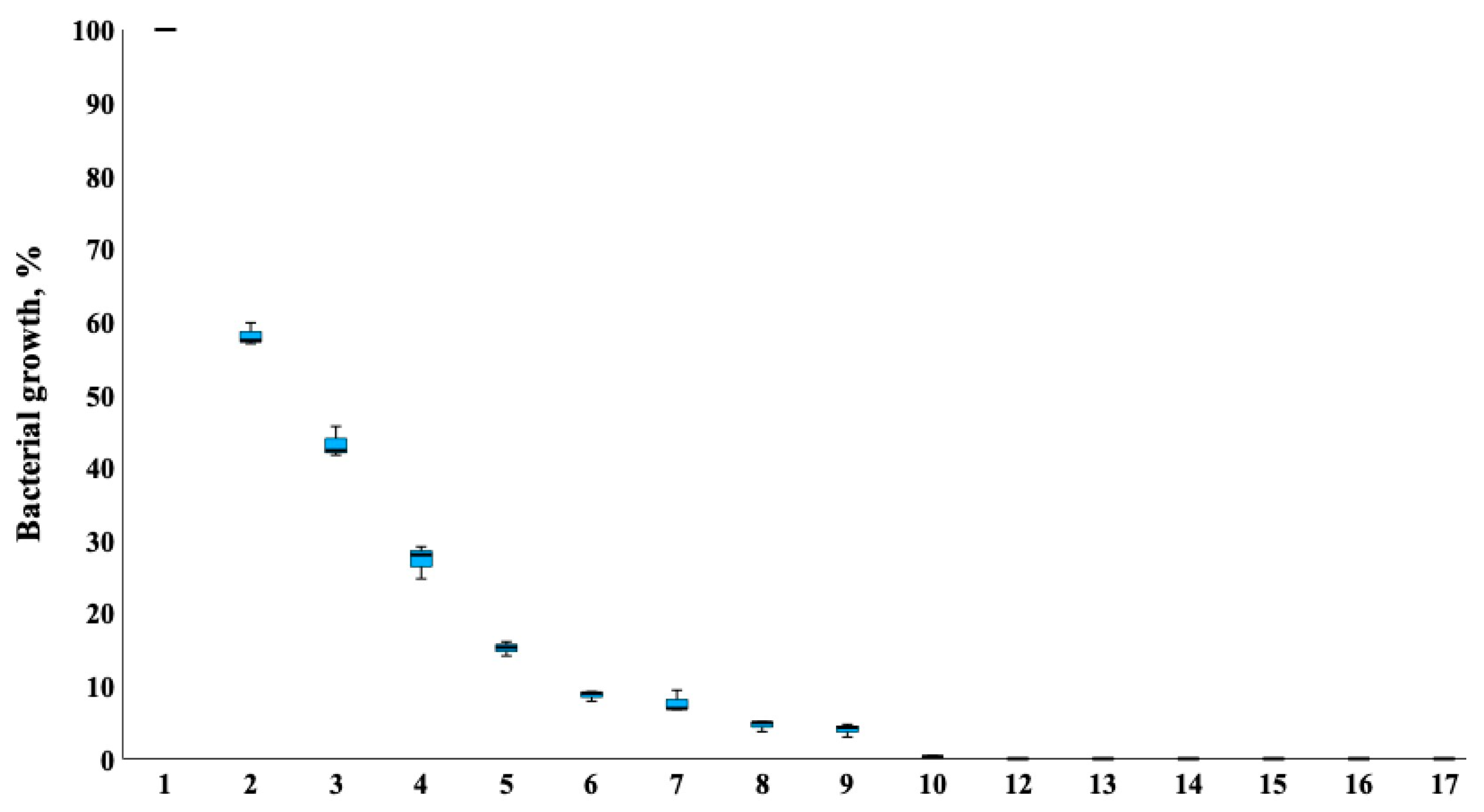
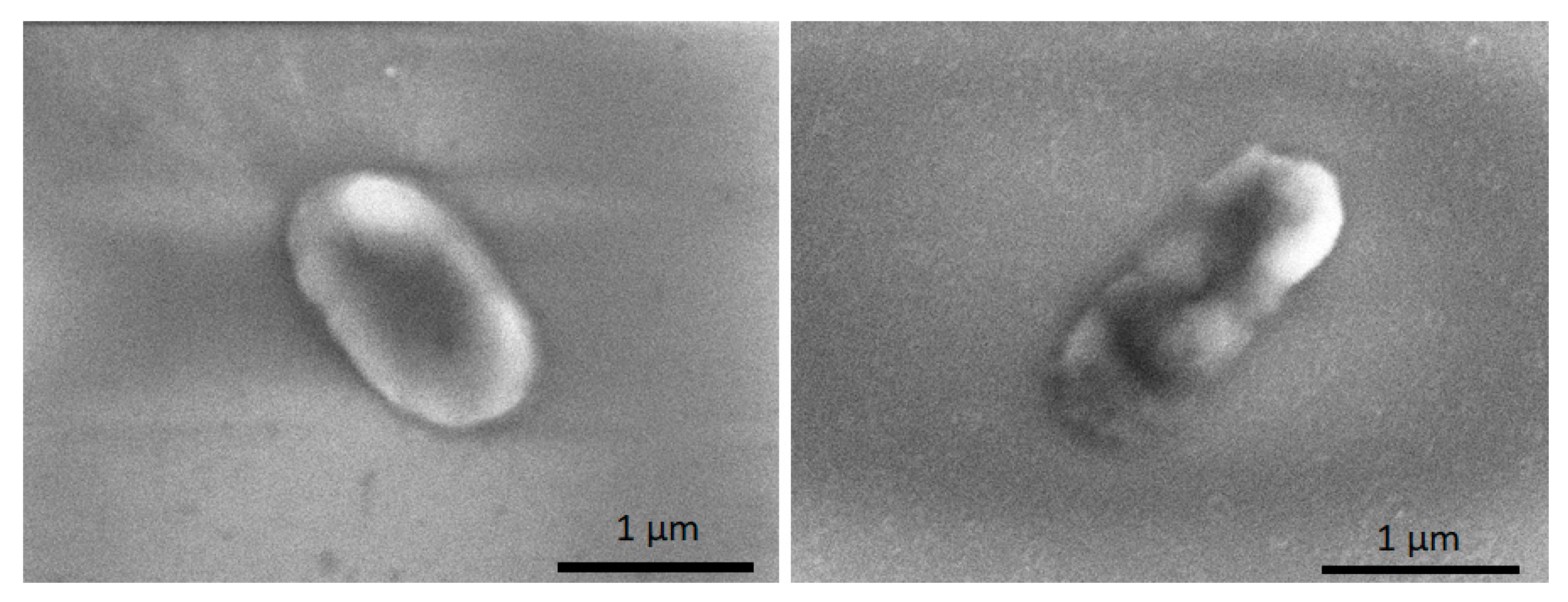
| Sample | Top Layer Elemental Composition, at. % | ||||||||
|---|---|---|---|---|---|---|---|---|---|
| Si | O | Fe | Na | Mg | Ca | K | S | Al | |
| Before deposition | 24.06 | 60.19 | 0 | 9.66 | 2.24 | 2.69 | 0.50 | 0.14 | 0.52 |
| After Fe2O3 NP deposition | 26.23 | 56.06 | 1.96 | 9.44 | 2.39 | 2.60 | 0.65 | 0 | 0.68 |
| Sample | Top Layer Elemental Composition, at. % | ||||||
|---|---|---|---|---|---|---|---|
| O | C | Fe | Si | Na | Ca | Al | |
| Before deposition | 50.2 | 23.6 | - | 20.6 | 3.4 | 1.1 | 1.1 |
| After Fe2O3 NP deposition | 41.1 | 40.0 | 17.9 | - | 1.0 | - | - |
Disclaimer/Publisher’s Note: The statements, opinions and data contained in all publications are solely those of the individual author(s) and contributor(s) and not of MDPI and/or the editor(s). MDPI and/or the editor(s) disclaim responsibility for any injury to people or property resulting from any ideas, methods, instructions or products referred to in the content. |
© 2023 by the authors. Licensee MDPI, Basel, Switzerland. This article is an open access article distributed under the terms and conditions of the Creative Commons Attribution (CC BY) license (https://creativecommons.org/licenses/by/4.0/).
Share and Cite
Giedraitienė, A.; Ružauskas, M.; Šiugždinienė, R.; Tučkutė, S.; Grigonis, K.; Milčius, D. Development of Antibacterial Cotton Textiles by Deposition of Fe2O3 Nanoparticles Using Low-Temperature Plasma Sputtering. Nanomaterials 2023, 13, 3106. https://doi.org/10.3390/nano13243106
Giedraitienė A, Ružauskas M, Šiugždinienė R, Tučkutė S, Grigonis K, Milčius D. Development of Antibacterial Cotton Textiles by Deposition of Fe2O3 Nanoparticles Using Low-Temperature Plasma Sputtering. Nanomaterials. 2023; 13(24):3106. https://doi.org/10.3390/nano13243106
Chicago/Turabian StyleGiedraitienė, Agnė, Modestas Ružauskas, Rita Šiugždinienė, Simona Tučkutė, Kastytis Grigonis, and Darius Milčius. 2023. "Development of Antibacterial Cotton Textiles by Deposition of Fe2O3 Nanoparticles Using Low-Temperature Plasma Sputtering" Nanomaterials 13, no. 24: 3106. https://doi.org/10.3390/nano13243106
APA StyleGiedraitienė, A., Ružauskas, M., Šiugždinienė, R., Tučkutė, S., Grigonis, K., & Milčius, D. (2023). Development of Antibacterial Cotton Textiles by Deposition of Fe2O3 Nanoparticles Using Low-Temperature Plasma Sputtering. Nanomaterials, 13(24), 3106. https://doi.org/10.3390/nano13243106






